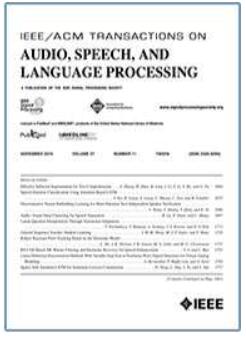为基于外推法的时态知识图谱推理学习动态和静态表征
IF 5.1
2区 计算机科学
Q1 ACOUSTICS
IEEE/ACM Transactions on Audio, Speech, and Language Processing
Pub Date : 2024-10-23
DOI:10.1109/TASLP.2024.3485500
引用次数: 0
摘要
时态知识图谱推理旨在预测未来时间戳中缺失的环节(事实)。然而,大多数现有方法都有一个共同的局限性:它们侧重于学习时态知识图谱的动态表征,而很少考虑随时间变化而保持不变的静态特征。为解决上述问题,我们提出了学习时态知识图推理(DSTKG)的动态和静态表征,引入两个潜变量来捕捉时态知识图中实体的动态和静态特征。首先,我们使用基于 Bi-GRU 的推理网络来学习历史事实的静态潜表征,并使用基于离散时间转换的非线性推理网络来学习动态潜表征。然后,我们使用重参数化技巧对潜变量进行多次采样,以获得高质量的嵌入,并对未来的时间戳进行预测。四个基准数据集的实证结果表明,我们的模型比最先进的方法更有效。与强大的基线模型 DBKGE (RotatE) 相比,就评估指标 MRR 而言,所提出的模型在 Yago11k、Wikidata12k、ICEWS14 和 ICEWS05-15 上的性能分别提高了 2.69%、1.59%%$、1.18% 和 1.22%。本文章由计算机程序翻译,如有差异,请以英文原文为准。
Learning Dynamic and Static Representations for Extrapolation-Based Temporal Knowledge Graph Reasoning
Temporal knowledge graph reasoning aims to predict the missing links (facts) in the future timestamps. However, most existing methods have a common limitation: they focus on learning dynamic representations of temporal knowledge graphs and rarely consider static characteristics that remain unchanged over time. To address the above issues, we propose to learn the dynamic and static representations for temporal knowledge graph reasoning (DSTKG), which introduces two latent variables to capture the dynamic and static characteristics of entities in temporal knowledge graphs. First, we use a Bi-GRU-based inference network to learn the static latent representation of historical facts and a nonlinear discrete-time transition-based inference network to learn the dynamic latent representation. Then, we sample the latent variables multiple times using re-parameterization tricks to obtain high-quality embeddings and make predictions in the future timestamps. The empirical results on four benchmark datasets show that our model is more effective than state-of-the-art approaches. Compared with the strong baseline model DBKGE (RotatE), the proposed model achieves performance improvements of 2.69%,
$1.59\%$
求助全文
通过发布文献求助,成功后即可免费获取论文全文。
去求助
来源期刊

IEEE/ACM Transactions on Audio, Speech, and Language Processing
ACOUSTICS-ENGINEERING, ELECTRICAL & ELECTRONIC
CiteScore
11.30
自引率
11.10%
发文量
217
期刊介绍:
The IEEE/ACM Transactions on Audio, Speech, and Language Processing covers audio, speech and language processing and the sciences that support them. In audio processing: transducers, room acoustics, active sound control, human audition, analysis/synthesis/coding of music, and consumer audio. In speech processing: areas such as speech analysis, synthesis, coding, speech and speaker recognition, speech production and perception, and speech enhancement. In language processing: speech and text analysis, understanding, generation, dialog management, translation, summarization, question answering and document indexing and retrieval, as well as general language modeling.
 求助内容:
求助内容: 应助结果提醒方式:
应助结果提醒方式:


